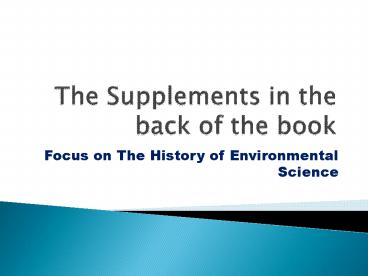The Supplements in the back of the book PowerPoint PPT Presentation
1 / 25
Title: The Supplements in the back of the book
1
The Supplements in the back of the book
- Focus on The History of Environmental Science
2
Supplements
- Fundamentals, Extensions of information, ideas
found in each chapters - More detail, More Facts and Figures to support
concepts discussed. - Lots of charts and maps
3
Supplement Topics Include
- Supplement 3 Economic, Population, Hunger,
Health, Pollution maps, data - Supplement 4 Biodiversity, Ecological
Footprints, Environmental Performance Maps - Supplement 5 Basic Chemistry
- Supplements 7 and 9 Biology topics
- Supplements 8, 10 Climate, energy maps info
- Supplement 11,12 Trade, Religion and the
environment
4
You are responsible for being aware of the
information contained in them
- Only 1 supplementary is required reading
- 5 Environmental History
5
How history and Environmental Science Connect
- Recent work points to numerous connections
between environmental problems and the collapse
of past civilizations. - Easter Island
- Greenland, Iceland, Vikings in America
- Saharan cultures (Romans)
- Samaria and the first civilizations in the Iraq
- Anasazi (cliff dweller indians in NA)
6
Easter Island
7
Easter Island Revisions to a Popular
Environmental Story
- Some revisions in a popular environmental story
- Polynesians arrived about 800 years ago, not 2900
- Population may have reached 3000, not 15,000
- Used trees in an unsustainable manner, but rats
may have multiplied and eaten the seeds of the
trees, permanently keeping the island deforested - Disease and Slavers from SA did most the
depopulating of the island, not cannibalism
8
AuthorJared Diamond
- Specializes in Biogeography
- Focused on societies, their interaction with each
other and the environment
9
Looking at mistakes in the past may help us make
the right choices today
- Iceland
10
Environmental Science and environmental ideas
are relatively new
- North Americans who played an important role
promoting environmental awareness - Henry David Thoreau wrote Life in the woods
- John Muir, Founder of Sierra Club,
preservationist - Teddy Roosevelt , conservationist, forest service
GC - FDR and the Great Depression, CCC, gov depts, P
health - Rachel Carson Silent Spring effects of DDT,
quality - 70s presidents, Nixon, Ford, Carter EPA,
Energy, Alaska - Theo Coburn Our Stolen Future Hormone and
chemicals
11
Presidents with other goals
- Herbert Hoover return all federal land to the
states to be sold - Ronald Reagan (Sagebrush Rebellion) Increased
sales, reduced funding - George W. Bush, Actions like RR, withdrew from
Kyoto accords concern global warming
12
Environmental Catastrophes
- Killer fog/smog in London (1880,1952, 1956)
- A polluted river near Cleveland catches fire
(1969) - Love Canal housing project abandoned because of
toxic wastes (1978) - Three mile Island Nuclear Accident (1979)
- Bhopal, India (1984)
- Chernobyl (1986)
- Coal seem fires in WV and Centralia PA
13
Cuyahoga River , Ohio 1969
14
Bhopal Gas tragedy 1984
25 yrs on Bhopal water still toxic
15
Love Canal Housing Project
16
Environmental Concerns are Global
- The air pollution in major Chinese cities
starting to make its way to the west coast
17
Individuals can make a difference
- George Bush and the Marine Reserve Park he signed
into law
18
Your Questions?
- Connected to the information presented in this
chapter
19
Homework (Due, typed)
- Read supplement 5
- From all the items listed on the time line,
select the 10-12 people, actions or events in
North American Environmental history you consider
most important. - For each, write a comment why you personally
think the items you selected are important - Pick one items from your selection and be
prepared to talk about it in class (pictures,
email)
20
Start of UN Environmental Issues Project
- Purpose To better understand the interactions
between environment, people and nations of the
world - Completed by END of School YEAR
- The other side of the UN besides peacekeeping
and humanitarian aid - Job each student selects a Country, collect info
about country and its environmental issues
21
UN Project
- 5. By the end of MAY Prepare environmentally
focused resolutions to place before the council
to be debated and voted upon. - Each chapter we cover in class will introduce new
questions on which you need to gather information - Use any source, but document, double-check
(bibliography) - 8. Place info in a separate section of
comp - books, notes (will check
periodically)
22
First step
- Choose 4 countries, eventually you will
concentrate on just one - Pick numbers from 1-192
- Answer the following questions
23
First set of Questions
- What is the countrys location, neighboring
countries, and major types of topography - Copy or draw its flag, and indicate major
languages, religions - Is this country developed, MDC, LDC?
- Form of government, ideal and in reality
24
First set of questions, continued
- Is there economic growth? If there is, is it
sustainable? What are the largest employers? - What is your estimate of the ecological footprint
of the average person in the country? - Wide spread diseases throughout country?
- 8. Any notable environmental problems disasters,
events that have occurred?
25
Homework Part 2
- Read up on the 4 countries selected
- Pick the most interesting one or two
- Remember, when you attend the council in MAY, you
represent the country from the viewpoint of
whats best for the country, not your own
philosophy

